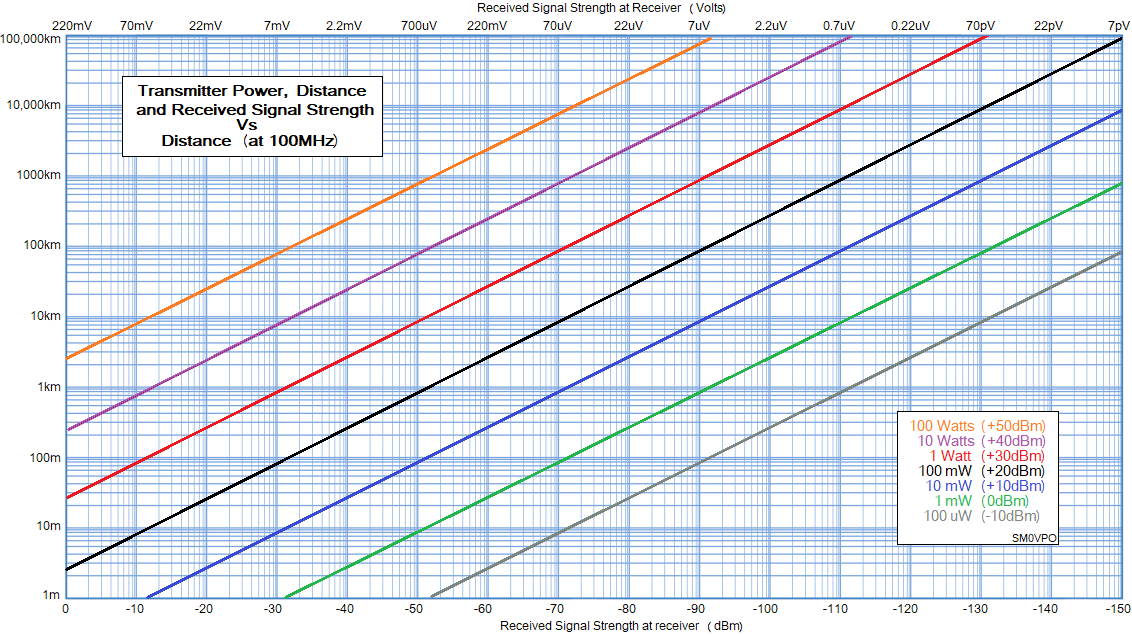

"What sort of a range can I expect with your FM transmitter?". This is a question I used to be asked quite often. The answer is quite complex, and if you look at the table below, you will see it can also be very surprising.
The answer is that range is not very dependent on the transmitter power, but many other factors, such as:

Let us assume that you are using my V8 180mW FM transmitter with my VPOle antenna (opens in a new tab). The transmitter has an output of +22.5dBm. The antenna has a gain of 3dB. Your radio telescopic antenna with a gain of -3dB (a loss). In other words, antenna gains are 0dB.
Let us also assume that you are in a high hot-air baloon at both the transmitter and receiver sites: a "Free-Space Path" (FSP), or "Line Of Sight" LOS). The table below will give you the maximum distance, total pathloss, received signal power in dBm and Volts (RMS).
| Distance | Pathloss [dB] | Signal | Power [W] | Volts [RMS] | Typical radio |
|---|---|---|---|---|---|
| 1m | 12.44dB | +10dBm | 10mW | 707mV | Radio receiver no antenna |
| 10m | 32.44dB | -10dBm | 100µW | 71mV | Cavity diode detector receiver |
| 100m | 52.44dB | -30dBm | 1µW | 7mV | Poor/bad FM radio |
| 1km | 72.44dB | -50dBm | 10nW | 707µV | Cheap $2.50 FM radio |
| 10km | 92.44dB | -70dBm | 100pW | 71µV | Average FM radio |
| 100km | 112.44dB | -90dBm | 1pW | 7µV | High quality FM radio (eg. Tecsun) |
| 1000km | 132.44dB | -110dBm | 10fW | 0.7µV | Not possible for WBFM radio receivers |
| 10 000km | 152.44dB | -130dBm | 100aW | 0.07µV | Not possible for WBFM radio receivers |
One small point is that the distance is limited by the "noise floor", which is related to the signal bandwidth. Wide-band FM has a signal bandwidth of 150kHz (±75kHz), so the door is open for loads of noise. If you reduce the bandwidth (eg, AM bandwidth = 4.5kHz), then you will get only 3% of the noise, resulting in an increase in receiver sensitivity. Signal-to-noise ratio increases by 30X. This gives a much greater range, perhaps 5X the distance.

I have just bought a little Tecsun PL-330 receiver and it can just about detect WBFM at 7µV, albeit noisy, and SSB at 0.35µV. But this is a really exceptional radio. Your average domestic FM radio will need around 70µV to get a readable WBFM signal. You can see from the table that I could receive the transmitter at 100km distance in the baloons and using my Tecsun PL330, but only 10km using a typical portable radio. This means I could claim 100km range "under ideal conditions". If you added a 10-element Yagi-Udda antenna (10dB gain) to both transmitter and receiver, then the 20dB signal gain would give 10x the distance, or theoretically 10,000km with the Tecsun PL330, and 1000km with a typical portable radio.
Let us now come back down-to-Earth; if the VPOle antenna were used on the roof of a house, 20m above the ground, then the distance to the horizon would be about 16km. If the receiver was on the roof of a building then it would be easy to achieve 25km, assuming there are no obstruction. If the receiver was at ground level, between buildings, then you could expect a 20dB reduction, or only about 7km. Now use a cheap US$2.5 FM radio from E-Bay and the range could be as little as 2.5km.
Look at this in graphic form:


The "hypothetical" scenario I gave above, with extremely high antennas, is not hypothetical for aviation. If you spew out 100mW and you are getting 5km distance with your radio receiver at ground level, then be aware that aircraft fly at typically 10km high, so any spurious output could cause serious interference over very long distances. The VHF aircraft band is 108-137MHz, which is right beside the VHF FM band.
Be aware that is is illegal in most countries to set up a radio transmitting station. In Spain, for example, all local radio stations are licensed and all are effectively pirates. If you operate sensibly in Spain, then the authorities turn a blind eye, and even help you (unofficially) to avoid interference by choice of frequency. In the United kingdom, however, you can expect heafty fines and confiscation of all your transmitting and test equipment. In some countries you could expect to be carted away, never to be seen again.

I hope that this information has given you some "food for thought". You can always e-mail me at harry.lythall@[my domain].com. You can even use oeieio@hotmail.com or hotmail@sm0vpo.com as they are both valid e-mail accounts for me 😉 although I would prefer that you visit my messageboard if you have any questions about this or any other project. I always look forward to receiving feedback, positive or negative ☺

Very best regards from Harry - SM0VPO
Return to INFO page